Murtoa Stick Shed facts for kids
Quick facts for kids Murtoa Stick Shed |
|
|---|---|

Exterior, February 2018
|
|
| Location | Murtoa, Victoria, Australia |
| Built | 1942 |
| Official name: Murtoa No.1 Grain Store | |
| Type | Listed place |
| Designated | 1 October 2014 |
| Reference no. | 106149 |
| Lua error in Module:Location_map at line 420: attempt to index field 'wikibase' (a nil value). | |
The Murtoa Stick Shed, also known as the Number 1 Emergency Grain Store, is a huge building in Murtoa, a town in the Wimmera region of Victoria, Australia. It was built to store large amounts of grain.
This amazing structure is located right next to the railway line in the big wheat-growing area of western Victoria. It's a really important part of Australia's history, especially linked to farming and World War Two.
Contents
Building the Giant Shed
The Murtoa Stick Shed was built very quickly between September 1941 and January 1942. It was needed because Australia had a lot of wheat but couldn't easily sell it overseas during World War II.
A Unique Design
To build this massive shed, workers used 560 tall, upright poles. Some of these poles were as long as 80 feet! Many more poles were used to create the roof and support the structure.
These slender poles were likely salvaged from mountain ash trees. These trees had been burnt during the terrible 1939 bushfires in places like Powelltown, Noojee, and Erica.
How Big Is It?
The Murtoa Stick Shed is incredibly long, stretching 870 feet (about 265 meters). It's 198 feet (about 60 meters) wide and nearly 63 feet (about 19 meters) high at its peak. This means it covers a huge area of 170,000 square feet. It could hold an enormous 3.4 million bushels of wheat, which is about 95,000 tonnes!
Why Was It Built?
In the late 1930s, Australia had a problem: too much wheat! Usually, Australia would export a lot of its wheat to places like Great Britain and Western Europe. However, world trade changed, and shipping became difficult, especially with World War II starting in 1939.
Wheat Piles Up
Australia was producing about 150 to 160 million bushels of wheat each year. About 100 million of those bushels were usually sold to other countries. But with the war, it became hard to ship the wheat away.
At the time, only 48 of the 160 grain silos planned for Victoria had been built. This meant there wasn't enough storage for all the extra wheat. So, the Murtoa Stick Shed was built as an emergency solution.
Wartime Ingenuity
Because of wartime shortages, builders had to be clever. They used traditional bush construction methods, adapting them to build this huge structure. It's even said to be the largest "rustically-built" structure in the world! This means it was built using simple, natural materials and methods, often without highly processed timber.
The Forests Commission Victoria helped by supplying a huge amount of poles from state forests for these emergency wheat storage sheds.
History and Importance
The Murtoa Stick Shed was the very first emergency bulk wheat storage shed built in Victoria. It's also the only one of its kind still standing in Australia today.
A Temporary Solution
The shed was filled with wheat within six months of being built. The wheat stayed in storage there until 1944.
Another, even larger, Stick Shed was built in Murtoa in 1942-43. It could hold twice as much wheat! However, this second shed was taken down in 1975.
Becoming a Heritage Site
Over time, the Murtoa Stick Shed No. 1 became very expensive to look after. It was eventually stopped from being used for storage in 1989.
However, its importance was recognized. In 2014, the building was added to the Australian National Heritage List. This listing means it's seen as a significant part of Australia’s history, showing how important the wheat industry was and how World War Two affected people at home.
Images for kids


